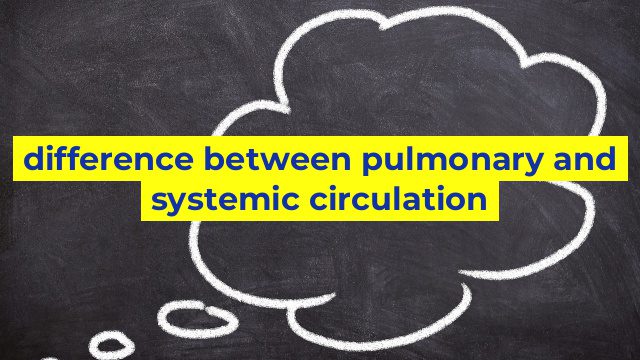The Difference Between Pulmonary and Systemic Circulation
Introduction
The human body is made up of many complex systems that work together to keep us alive and functioning properly. One of these systems is the circulatory system, which is responsible for transporting blood, nutrients, and oxygen throughout the body. Within the circulatory system, there are two types of circulation: pulmonary circulation and systemic circulation. In this article, we will explore the difference between these two types of circulation.
Pulmonary Circulation
Pulmonary circulation refers to the movement of blood between the heart and the lungs. When we inhale, oxygen enters our lungs and is exchanged for carbon dioxide. Pulmonary circulation ensures that this oxygen-rich blood is transported from the lungs back to the heart, where it is then pumped out to the rest of the body.
The pulmonary system includes the pulmonary artery, which carries deoxygenated blood from the heart to the lungs, and the pulmonary vein, which carries oxygenated blood from the lungs back to the heart. This circulation is responsible for maintaining the proper levels of oxygen in the body.
Systemic Circulation
Systemic circulation involves the movement of blood throughout the rest of the body after it has left the heart. This type of circulation delivers oxygen-rich blood to the organs and tissues of the body, including the muscles, brain, and skin. In addition, systemic circulation also helps to remove waste and carbon dioxide from the body.
The system circulation consists of the aorta, which carries oxygen-rich blood from the heart to the rest of the body, and the vena cava, which returns deoxygenated blood to the heart to be pumped to the lungs for oxygenation.
The Difference Between Pulmonary and Systemic Circulation
The key difference between pulmonary circulation and systemic circulation is the path that the blood takes. Pulmonary circulation involves the movement of blood between the heart and lungs, while systemic circulation involves the movement of blood throughout the rest of the body.
Another key difference is the role that each type of circulation plays in the body. Pulmonary circulation is responsible for transporting oxygen-poor blood to the lungs to be oxygenated, while systemic circulation delivers oxygen-rich blood to the rest of the body for use by the organs and tissues.
Conclusion
In conclusion, understanding the difference between pulmonary and systemic circulation is important for anyone interested in learning about the circulatory system. While both types of circulation are essential for maintaining the proper levels of oxygen and nutrients in the body, they serve different roles and follow different paths. By understanding these differences, we can better appreciate the complexity and importance of the circulatory system.
Table difference between pulmonary and systemic circulation
| Characteristics | Pulmonary Circulation | Systemic Circulation |
|---|---|---|
| Definition | The circulation of blood between the heart and the lungs. | The circulation of blood between the heart and the rest of the body. |
| Function | To oxygenate the blood and remove carbon dioxide. | To supply oxygen and nutrients to the body tissues and remove waste products. |
| Vessels involved | Pulmonary arteries, pulmonary veins, and capillaries. | Arteries, veins, and capillaries of the rest of the body. |
| Pressure | Low pressure | High pressure |
| Resistance | Low resistance | High resistance |
| Blood flow | Low volume, high velocity | High volume, low velocity |
| Blood gas composition | Deoxygenated blood in pulmonary arteries and oxygenated blood in pulmonary veins. | Oxygenated blood in arteries and deoxygenated blood in veins. |


